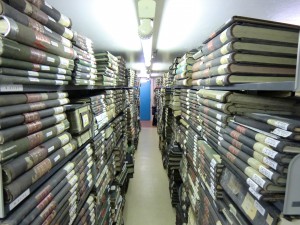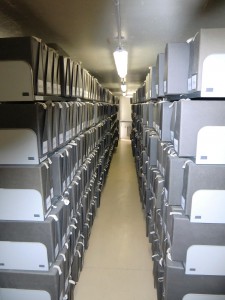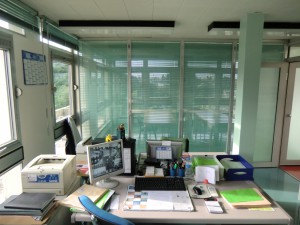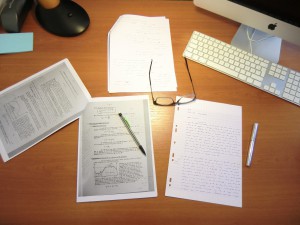Interview of Guillaume Yon
Your PhD thesis ‘EDF and the construction of national economy’ is primarily based on the exploitation of the archives of Electricité of France (EDF). How did you come to making these archives the main source of your research?
As is so often the case, it was a combination of a pre-existing interest and of empirical luck.
I was interested in the debates on the nature of economics, its role in our societies. Michel Callon has written extensively on this topic, and my PhD thesis is in line with his proposals. In brief, he suggests to drop the idea that an economist applies market laws everywhere, unambiguous and a-historic laws similar to the laws of gravitation. Callon writes that economic science rather attempts  to describe and invent concrete socio-technical devices, which composition remains open and has to be debated. He often refers to a study by the economists Gerald Faulhaber and William Baumol. They raise the same problem about the status of economics and hesitate between both positions.
to describe and invent concrete socio-technical devices, which composition remains open and has to be debated. He often refers to a study by the economists Gerald Faulhaber and William Baumol. They raise the same problem about the status of economics and hesitate between both positions.
Facing this dilemma Faulhaber and Baumol call forth basic pillars of the history of economic theory in order to try to decide between both positions. They isolate seven major discoveries. Among them is the theory of marginal cost pricing, so-called theory of Ramsay-Boiteux, and the theory of peak demand pricing, so-called theory of Boiteux-Steiner. These are results achieved by Marcel Boiteux while he was a young EDF engineer-economist in the 1950s. He was in charge of building the pricing policy of the new public monopoly.
I had heard a little about the theorems in question, like anyone with a basic knowledge of economics. They were developed by two leading economists as essential innovations at the forefront of the debates on the nature of economics. As I read this, I thought that investigating their genesis could help fostering discussion on the economist’s position and on the type of knowledge he produces, between the laws of general equilibrium, moral questions and technical choices.
This is where luck comes in. I found out that EDF has an archive center in Blois. I went there, without knowing exactly what to expect. If there wasn’t enough material I was ready to look for other  fields of investigation. It was very exploratory.
fields of investigation. It was very exploratory.
I soon realized that these archives were offering a unique opportunity to observe economists at work. I was able to consult the registered day-to-day construction of the theory of optimal pricing and simultaneously the concrete price list of EDF. It was both reassuring and overwhelming. Boiteux especially, but also some of his collaborators, have deposited all their documents with these archives. There is a colossal mass of documents regarding the elaboration of the EDF pricing, and more broadly the actual search for economic optimum. Documents range from articles published in academic journals to handwritten drafts, and memos in all their forms. There are meetings reports colloquiums, speeches transcriptions, many of the engineers-economists’ correspondence with ministries, trade unions, other economists… and even appointment books! All of this is unexploited, because the historians of EDF have focused on the strategy of the company (in particular the nuclear issue) or the emblematic social affairs. Very few is known about economic calculation. Valuing these deposits has become my PhD research work’s core issue.
The brutal appearance of a world that has now totally disappeared is quite breathtaking. There is also a demiurgic sensation: the existence of this world, what it may tell us for and on our present, is only up to your decision to explore the archives. One of the main objectives of the thesis is to remain consistent with this approach to the archives.
So how do you concretely work on archives?
In the dust! More seriously, the process is extremely codified. It begins with the consultation of a catalog of deposit slips. There is a brief note for each archive box which summarizes its contents. A part of this catalog is computerized, which allows for a search by key words. But the computerization does not reduce the importance of the archivist who knows well the archival materials he is responsible for. His role is crucial, since he guides the researcher to the boxes he may be interested in. Once identified, the potentially relevant boxes must be requested from the archivist. The boxes are not freely accessible on shelves. It is necessary to check that the documents may be communicated. The communicability rules are complex, the issues of privacy mix with to the fact that EDF is an active company which has secrets, and more widely, industrial interests to defend, not to mention the sensitivity of the information relating to the nuclear power. It is moreover why, once the  boxes are picked up by the archivists from kilometers of shelf spaces stored on several floors, the consultation takes place in a glazed room, from which the archivists can observe the researchers at work. The next stage, facing the box, is unpredictable. A very tempting deposit slip can bring a disappointing box and vice versa, which explains the considerable amount of time spent sorting out and reading documents. Hard choices have to be made in many occasions during this phase of work, and each time with the fear missing a treasure! Once the boxes are identified, the tedious work begins: photograph the documents so that they can carefully be studied at home.
boxes are picked up by the archivists from kilometers of shelf spaces stored on several floors, the consultation takes place in a glazed room, from which the archivists can observe the researchers at work. The next stage, facing the box, is unpredictable. A very tempting deposit slip can bring a disappointing box and vice versa, which explains the considerable amount of time spent sorting out and reading documents. Hard choices have to be made in many occasions during this phase of work, and each time with the fear missing a treasure! Once the boxes are identified, the tedious work begins: photograph the documents so that they can carefully be studied at home.
The following phase calls for another type of reading, more attentive this time. It requires drafting short summaries that will be useful memory aid. This part of the work is very much like a criminal investigation. Documents were not written for the historian! They are like lumps of dead wood, the reader’s first experience is total disorientation. It is not clear who speaks to whom, nor when, nor what “they” talk about, and when it comes to determining why “they” started talking about it … It is easily to imagine the hallway discussions and the meetings which remain unaccounted for. It is also easy to imagine emergency situations surrounding the production of certain documents, which lead the author not to clarify the issues at stake. This is where business archives differ from national archives that relate to the State, and are more familiar to historians. The State takes, by construction if I may say so, a forward-looking view of history. State actors know that they write for posterity and that they will be judged by posterity (which raises particular problems). In a company department (the General Economic Research department of EDF) concerns about the burden of posterity are much less obvious! Be that as it may, the reader (painfully) realizes the extent of implicit in all this written production. The experience demonstrates how strongly each written item is situated, is  rooted in an extra-textual context where it seeks to bring about changes that are always difficult to grasp.
rooted in an extra-textual context where it seeks to bring about changes that are always difficult to grasp.
The short summaries thus serve to gather information for future data matching. The stabilization of issues and of a chronology of when these issues have been dealt with results from a continuous work searching for overlaps and recurrences that emerge only gradually. Pieces of evidence, bringing them together: so many efforts spent on rebuilding the world I was talking about earlier, of which only partial bits and pieces, with missing details, are left; and a world that is so different from ours.
What effects may be expected from such a reconstruction?
There is a tension, which for me is still open, between two possible effects of staying close to the archives when I am writing.
Staging the distance is one of the possible effects. Our world, today’s electric France, has nothing more to do with France during the nationalization of electricity. The immersion in archives enables stepping back from our present. This is not only to say, at a rather obvious level, that there is nothing natural about the deregulation of the electricity market and its opening to competition. This is a very controversial issue and the actors themselves often invoke Marcel Boiteux’s name. We can go further, for example with the following reasoning. The participation of the groups concerned by the development of the trade formulae has been the subject of considerable discussion. The case of the electric rates of EDF allows to identify problems raised by such an injunction. The ones who really participate in the calculations within EDF can be counted on the fingers of one hand. EDF experience shows, somewhat against the stream, that the calls from concerned groups to participate in the development of markets will remain very naive if they do not face the problem of the elaboration of procedures that make multitudes participate in the calculation of the optimum. In other words, we make the archive play by contrast with the current efforts, in order to provide more visibility to the present problem.
There is also a more positive way of writing from archives. One can try to collect a dimension of the forgotten experience there; in order to remind it, deepen or promote it. This can take the  following shape. EDF is a public enterprise; its engineers-economists are particularly concerned with the issue of general interest. They thus have thought in practical terms and implemented solutions that address the issue of the intersection between calculation of optimization and morality. They provide us with a figure and a posture, maybe even a role and a function of the economist. It is interesting, and in my view important, to give this an echo in the contemporary debates on the place of the economic knowledge in our societies. There is much talk about economists’ connections to banks, the status of the public positions of some economists in the media, their work as the Prince’s advisor, or their place in a financial crisis that they had not at all seen coming. I think that it imports to recall the intuitions and the practical solutions set up by engineers-economists to address these issues. They derive their legitimacy from the configuration in which they were elaborated: as closely as possible to the concrete management of a company, within a mathematized practice that achieved academic recognition in the economics field, guided by the general interest. Archives enables to extract and then to depict, in a succession of small strokes, this practical posture, to highlight an original way of producing economic knowledge that does not avoid moral issues.
following shape. EDF is a public enterprise; its engineers-economists are particularly concerned with the issue of general interest. They thus have thought in practical terms and implemented solutions that address the issue of the intersection between calculation of optimization and morality. They provide us with a figure and a posture, maybe even a role and a function of the economist. It is interesting, and in my view important, to give this an echo in the contemporary debates on the place of the economic knowledge in our societies. There is much talk about economists’ connections to banks, the status of the public positions of some economists in the media, their work as the Prince’s advisor, or their place in a financial crisis that they had not at all seen coming. I think that it imports to recall the intuitions and the practical solutions set up by engineers-economists to address these issues. They derive their legitimacy from the configuration in which they were elaborated: as closely as possible to the concrete management of a company, within a mathematized practice that achieved academic recognition in the economics field, guided by the general interest. Archives enables to extract and then to depict, in a succession of small strokes, this practical posture, to highlight an original way of producing economic knowledge that does not avoid moral issues.
Moreover, this takes us back to the concreteness and the materiality of archives. I said earlier that the engineers-economists of EDF were not, unlike the central State, obsessed by the judgment of history. But they were obsessed by the present of the negotiations about rates and the near future of the implementation of the pricing rules. If we were able to collect so many documents, if somebody like Marcel Boiteux has kept and then decided to deposit all his archives without any restriction whatsoever, it is precisely because these practitioners of economy were attaching great importance to calculate general interest openly and publicly. This, in my opinion, is one of the utilities of an immersion in archives. They sound (including in their existence, in the fact that they have reached us) as a series of useful reminders for the present. Today, do we sufficiently think about the public writing of the economic formulae?
Photo #1: An aisle of EDF’s archives. The documents held in the archives occupy nearly 8 km of shelf spaces distributed over six levels. Here, the account books of the former companies which handled the electricity and gas production, transport and distribution before the nationalization in 1946. EDF has collected their archives. Photo : Guillaume Yon.
Photo #2: An aisle of EDF’s archives. In addition to the archives of the former companies and of EDF, the mixed archives of EDF-GDF are also kept at the Blois archives site. Photo : Guillaume Yon.
Photo #3: EDF’s Archives Consultation Room in Blois. In the foreground the desk of the technician in charge of welcoming the researchers; in the background the glazed room where the researchers consult the archives; between the two the metallic shutter that enables to see the researchers at work without being seen: panopticon. Photo : Guillaume Yon.
Photo #4: The composition of short summaries. On the left, an archive document photographed then printed; on the right, a short summary intended to be later used for data matching. Photo : Guillaume Yon.
Photo # 5: A page of a deposit slip. Photo : Guillaume Yon

